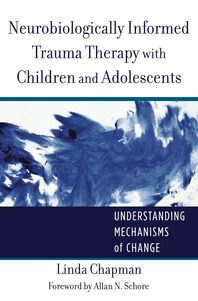
Neurobiologically Informed Trauma Therapy with Children and Adolescents
Understanding Mechanisms of Change
18 March 2014
Description
Nonverbal interactions are applied to trauma treatment for more effective results.
Also presented is the most recent knowledge of the role of the right hemisphere (RH) in development and therapy. Right brain communication, and how to recognize the non-verbal symbolic and unconscious, affective processes will be explained, along with examples of how the therapist can utilize art making, media, tools, and self to engage in a two-person biology.
Reviews
"Chapman writes convincingly about her treatment models. . . . [H]elpful to clinicians and aspiring practitioners. And, luckily, for those of us who simply want to learn something new about trauma or therapy, it’s written in a way that’s easy to understand even for non-professional readers." — PsychCentral
"I could not put this book down! This is a must-read volume that will deepen and enrich clinical understanding and greatly enhance clinical assistance to the many victims of trauma. A thoughtful, careful, well-informed clinician, Linda Chapman integrates science and her professional experience to explain the 'why's' of positive outcomes through expressive therapies and the models she has developed for addressing acute and chronic trauma. As she weaves together research data and accessible practice interventions, Chapman’s dedication to helping trauma survivors shines through in each page. I learned so much and can't wait to implement her models with my patients." — Eliana Gil, PhD, Founder, Gil Institute for Trauma Recovery and Education; Director, Starbright Training Institute for Child and Family Play Therapy; Past President, Association for Play Therapy
"This book is packed with clinical wisdom, scholarship, case studies, and detailed neurodevelopment correlates of relational trauma that illustrate the effective use of Chapman’s Art Therapy Treatment Intervention. The author makes an irrefutable case for art therapy’s place in the treatment of PTSD, acute and chronic trauma, and abuse in infants, children, and adolescents. A must-read and an inspiring contribution." — George Halasz, MD, Adjunct Senior Lecturer, School of Psychology and Psychiatry, Monash University, Melbourne, Australia
"In this well-researched book, Linda Chapman articulates a neurobiological understanding of trauma and a theoretically grounded model for the treatment of children and adolescents. Chapman uses moving case examples to illustrate how art can bypass left-brain activity and utilize regions of the brain where traumatic memories are stored. She describes how brain processing affects therapy at different stages, providing depth and clarity. Her style of working is informed, intuitive, theoretically grounded, and relational. This book is a long-awaited contribution to the field." — Gussie Klorer, PhD, ATR-BC, HLM, LCPC, LCSW, Professor Art Therapy Counseling Program, Southern Illinois University Edwardsville; author of Expressive Therapy with Troubled Children
"Imparting clinical wisdom derived from decades of practice as an art therapist with acutely and chronically traumatized children and youth, Linda Chapman presents detailed case examples in a down-to-earth, conversational style, demonstrating the careful, thoughtful, developmentally informed formulations underlying her interventions. This book is essential reading for child and adolescent therapists of all disciplines, supporting the importance of interventions which privilege the non-verbal aspects of therapeutic communication." — Susan C. Warshaw, EdD, ABPP, Board Certified in Psychoanalysis, Licensed Psychologist; Editor-In-Chief, Journal of Infant, Child and Adolescent Psychotherapy
"Drawing upon her extensive clinical experience as an art therapist, Linda Chapman has created a wonderful translational work. It is a major challenge but essential to bring complex neurobiological concepts into clinical practice, in order for our field to move forward and optimally help patients. The tightrope between neuroscientific jargon and distorting oversimplifications of translational implementation is hard to walk, but Linda Chapman does it with grace and respect. Highly recommended for anyone working with traumatized children and youth." — Bruce D. Perry, MD, PhD, Senior Fellow, The ChildTrauma Academy; Adjunct Professor, Department of Psychiatry and Behavioral Sciences, Feinberg School of Medicine, Northwestern University



